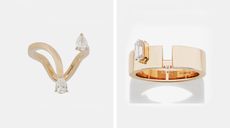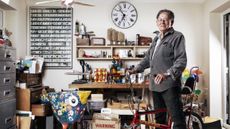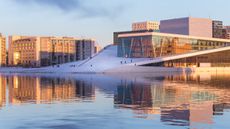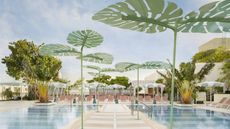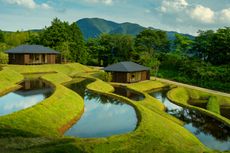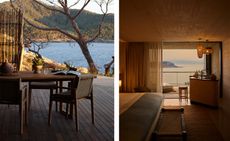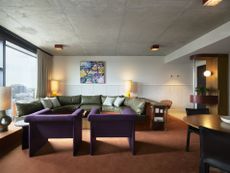Visit Valencia in 2023: what to see, from ceramics studios to coffee shops
Visit Valencia, as Wallpaper* contributor Blaire Dessent whisks us from an artful hotel to the birthplace of a classic Spanish cocktail in a design-led guided tour
- (opens in new tab)
- (opens in new tab)
- (opens in new tab)
- Sign up to our newsletter Newsletter
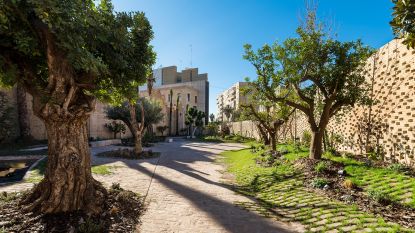
Design is everywhere when you visit Valencia, from the tiniest hole-in-the-wall café, to the 8km-long Turia park that runs the length of the city, and the 22 EV charging stations that are connected to solar-panelled street lamps. This Mediterranean city, where orange trees truly do line the avenues, boasts more than 300 days of sunshine a year, stunning examples of Modernista architecture and an impressive cultural heritage that dates back to the Phoenicians, but it is also a city with a vision of making life better for residents through green initiatives, new urban design projects and smart technologies, thereby creating a better place for visitors as well. In 2022 Valencia was the World Design Capital and European Capital of Smart Tourism (opens in new tab); in 2023 it will see the opening of the Hortensia Herrero Contemporary Art Centre, in 2024 it will be the European Green Capital and in 2026 the host of the Gay Games. It is safe to say the city is having a moment, and there could not be a better time to visit Valencia.
Visit Valencia: what to see and do
Only You Hotel

The lobby space at Only You Hotel, Valencia
Opened in 2021, the 191-room Only You Hotel Valencia has the heart of a boutique hotel, meaning intimate spaces and personal service, with all the fun amenities a bigger establishment can offer, such as a flower shop, an in-house tailor, gym and spa treatments. Rooms are cosy but not small, with an urban-elegant décor that mixes jewel tones of blue, red and green with darker wood and brass accents. The restaurant, located on the ninth floor, offers beautiful views over the city, alongside a comprehensive menu that leans traditional Spanish but with a contemporary twist.
onlyyouhotels.com (opens in new tab)
Café Madrid

Lounge space at Café Madrid
Known as the birthplace of Agua de Valencia, a potent mix of fresh orange juice, gin, vodka and cava, Café Madrid, albeit perhaps misnamed, is one of Valencia’s most beloved cocktail bars. With its eclectic mix of furniture, 19th-century art nouveau posters and crystal chandeliers, Café Madrid is a welcoming watering hole for day or night. Located in the heart of the old town, the creative cocktail menu is designed by Esther Medina-Cuesta, with a focus on local flavours and curious pairings.
myrhotels.com (opens in new tab)
Fran Café

The interior of Fran Café
Sunny, warm and retro vibes greet visitors who enter into this tiny corner coffee shop. From the funky 1970s-meets-The Flintstones font to the illustrated paper cups, Fran Café has a welcoming way about it, even if it’s meant for to-go clients. Pair a frothy café con leche or an espresso tonic with one of the homemade desserts that vary daily – from the dulce de leche-infused Argentinean alfajores to banana bread, and expect a delightful caffeine and sugar buzz to follow.
@francafe_es (opens in new tab)
Utopick

Utopick chocolate shop
Part chocolate shop, part artisanal chocolate factory, Utopick includes an award-winning line of bean-to-bar chocolate. The 70 per cent dark is a perfect, not-too-bitter-not-too-sweet combination; there’s line of dark, milk and white chocolate bars with added flavours such as milk and cookies (yes there is a cookie inside), orange and almond, and crunchy praline; and the ‘sweet words’ collection allows you to add your own message. If it wasn’t already hard enough to choose which to buy, the cool packaging makes it nearly impossible to limit your purchases.
utopick.es (opens in new tab)
Canoa Labs

Ceramic works by Raquel Vidal & Pedro Paz at Canoa Lab
Raquel and Pedro, the ceramic artists behind studio Canoa Labs, met while doing a master’s degree in artistic production in Valencia. She is from Almeria and he from Galicia, but both were drawn to the idea of setting up their studio in Valencia following graduation, in part for the city’s Mediterranean heritage, which is reflected in their handmade jars, pots and vessels. The showroom/studio in the Ruzafa neighbourhood offers the chance to see the pair’s distinctive practice that embraces ancient forms, particularly Greek and Roman, with textured, earthy surfaces that come from experimental glazing or elements of metalworking techniques.
canoalab.com (opens in new tab)
Rubio

The refitted Rubio stationery store
As delightful for adults as for kids, iconic, old-school Spanish educational brand Rubio, known for notebooks and stationery items for children, asked Valencia-based design firm Masquespacio to refit its store, which had been unchanged for nearly 60 years. The retro-futuristic design invites customers into another dimension, with interactive spaces for storytelling, a hall of colour that features vivid neon lighting, an augmented reality booth, and a time machine that tells the company’s history.
rubio.net (opens in new tab)
Bombas Gens

The cellar at Bombas Gens
A spectacular example of 1930s industrial and art deco architecture, Bombas Gens was once a factory for small machines and hydraulic pumps and is now home to a contemporary art centre run by the Per Amor a L’Art art foundation. The buildings underwent renovation in 2018 by Spanish architect Ramón Esteve with the input of Annabelle Selldorf on the museum part, during which a several-hundred-year-old bodega and a bomb shelter from the Spanish Civil War were uncovered and restored. Lush outdoor gardens and the on-site eatery, a Michelin-starred vegetarian restaurant run by Valencian chef Ricard Camarena, make a worthwhile trip to the off-the-beaten-path location.
bombasgens.com (opens in new tab)
Madre

Madre restaurant and cocktail bar
Chef Jose Mari, who earned his stripes at Mugartiz and La Surcusal, among others, prepares Latin-inspired food such as ceviches, causa limeña, and tacos, most of it meant for sharing, at this buzzing restaurant and cocktail bar, where music is an essential part of the atmosphere. Housed in a lime-green colonial-style house in El Cabanyal, a former fisherman’s neighbourhood now in transformation mode, Madre has two outdoor patios and an open indoor space that is filled with palm plants, long tiled tables and wooden benches.
lawebdemadre.com (opens in new tab)
Trinchera

The bar at Trinchera
Opened in May 2022 by chef Arturo Salvetti, Trinchera is a neighbourhood diner-meets-tapas bar with an old-school style. While the simple décor leans towards the industrial, with its white square tiles, stainless-steel countertops and metal hanging lamps, the atmosphere is all warm and friendly, with regulars hanging out chatting with the staff. The daily menu is scrawled on the tiled wall with a menu that focuses on locally sourced ingredients. House specialties include the huevos rotos (perfectly fried ‘broken’ eggs) with spicy tuna tartar and las marineras, a tapas-style dish of freshly made seafood salads on top of bread.
trinchera.es (opens in new tab)
Blaire Dessent is a freelance writer, editor and copywriter specialising in contemporary design, craft, art and travel. She works as the managing editor for TL magazine, a biannual, French/English art and design publication. In 2020 she was an editor and contributor to Imaginings by Kiki van Eijk, published by nai010. She is also the co-owner of The Alameda Shop, a creative lifestyle shop in Mallorca that works with contemporary artists and makers.
-
 Alternative engagement rings with an edge
Alternative engagement rings with an edgeAs the sales of engagement rings sky-rocket during lockdown, enjoy our off-kilter curation of edgy and unconventional engagement rings
By Hannah Silver • Published
-
 ‘The Art of Advocacy’: Aïda Muluneh’s vivid photographs are forces for change
‘The Art of Advocacy’: Aïda Muluneh’s vivid photographs are forces for changeAt Efie Gallery, Dubai, Aïda Muluneh’s upcoming show, ‘The Art of Advocacy’ (12 January – 24 February 2023) surveys the photographer’s art as a tool for change, and debuts a new work, revealed exclusively here
By Harriet Lloyd-Smith • Published
-
 Remembering the life and work of designer Tom Karen, who has died at the age of 96
Remembering the life and work of designer Tom Karen, who has died at the age of 96Tom Karen (1926 – 2022) was an industrial designer who delighted in the power of design to transport and transform, and shaped some of the most idiosyncratic icons of the 1960s, 1970s and beyond
By Jonathan Bell • Published
-
 Cosiest London cocktail bars for this frosty winter season
Cosiest London cocktail bars for this frosty winter seasonThe best London cocktail bars for winter, from a fairy-lit terrace in Fitzrovia to snug surrounds in Covent Garden
By Martha Elliott • Published
-
 Cocktails and concept stores: the ultimate Oslo tour
Cocktails and concept stores: the ultimate Oslo tourFrom an art-filled hotel to earthy cocktails and an in-house distillery, take our design-led Oslo tour – as guided by Wallpaper* contributor Will Jennings
By Will Jennings • Last updated
-
 Miami must-sees: discover the best of the city right now
Miami must-sees: discover the best of the city right nowDiscover Miami highlights, from cool bars and spas to elevating dining, experiential art and vintage design finds
By Maria Sobrino • Last updated
-
 Hong Kong tour: from vertical farming to whisky tasting, plus art, design and dining
Hong Kong tour: from vertical farming to whisky tasting, plus art, design and diningHead to Hong Kong and discover the best of the city right now with our design-led guide
By TF Chan • Published
-
 London tour: from architectural gardens to nose-to-tail dining, the best of the city right now
London tour: from architectural gardens to nose-to-tail dining, the best of the city right nowTake the Wallpaper* London tour – the latest in our design-led weekly travel round-up
By Martha Elliott • Last updated
-
 Kai Yufuin by Kengo Kuma revisits Japanese farmhouse architecture
Kai Yufuin by Kengo Kuma revisits Japanese farmhouse architectureHoshino Resorts has launched Kai Yufuin, a hot spring ryokan hotel by Kengo Kuma on the island of Kyushu in the Ōita Prefecture
By Feride Yalav-Heckeroth • Last updated
-
 The Beach Caves brings art, music and island spirit to Six Senses Ibiza
The Beach Caves brings art, music and island spirit to Six Senses IbizaThe Beach Caves, a new addition to the island’s Six Senses resort, unites creative luxury and Ibizan nights with its in-house recording studio and music on the rocks
By Martha Elliott • Last updated
-
 Flack Studio designs Ace Hotel Sydney in historical Tyne Building
Flack Studio designs Ace Hotel Sydney in historical Tyne BuildingFlack Studio designed interiors for the new Ace Hotel Sydney, opening in the historical Tyne Building, in the city's Surry Hills neighbourhood
By Pei-Ru Keh • Last updated
